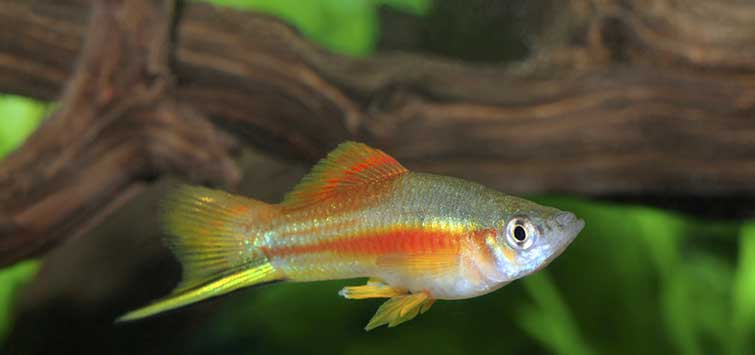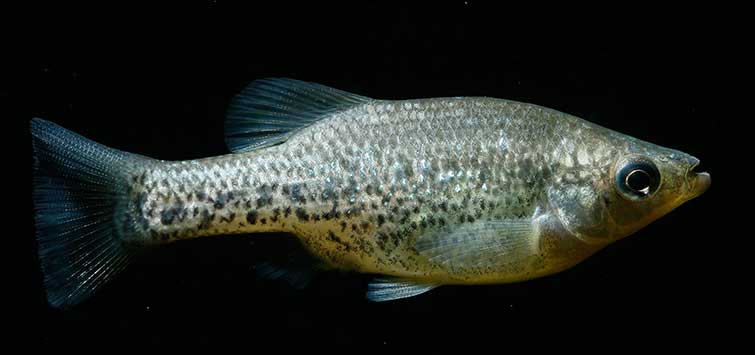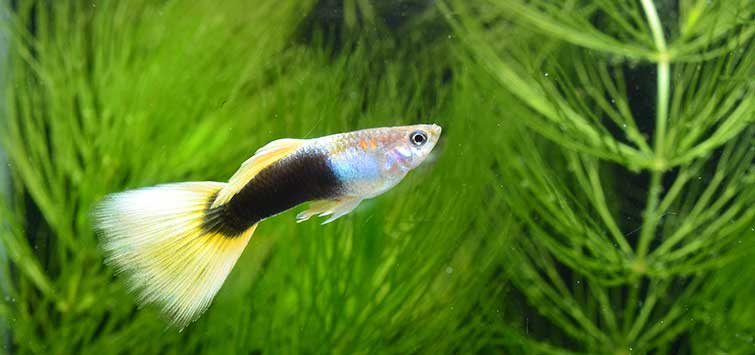Livebearers Unlimited: Fancy Livebearers 101
Author: Ted Coletti, PhD
Livebearers Unlimited: May 2007
No other aquarium fish have captured the hearts and minds of hobbyists and scientists alike more than our beloved livebearers. School kids study ‘em, older ones breed ‘em, and even-older ones competitively show them (that would be us adults). Every month a new published study or abstract appears about guppies, platies, swordtails, or mollies somewhere in the scientific literature. These are the same fish that form the core of today’s livebearer hobby and retail trade.
I am slowly moving more of my fishroom tank space toward fancy strain experimentation. With this issue of TFH being the ALA Convention 2007 Commemorative Issue, many of my livebearer pals have written some wonderful articles on the wild-type livebearers. So I’ll take the other side of the coin for this month’s column. I got many letters from hobbyists who want to learn the basics of selective breeding. This month’s for you!
Pet shop mollies, platies, swordtails, and guppies are considered “easy” fish. However, breeding them for size, color, and consistency is not easy. Some high-quality strains can be difficult just to maintain. So let’s review the basics of fancy livebearers and how to work with them to their fullest potential.
What Are Poeciliidae Fish?
The family Poeciliidae contains the core species used to create the fancy livebearers we’ve come to know and love. All were introduced at the dawn of the tropical fish hobby, circa 1908 here in the United States and a little earlier in Europe.
Fancy guppies are a highly developed version of Lebistes reticulatus, recently resurrected to its old genus. Their unique beauty is unmistaken. They do well in neutral to alkaline water, and temperatures in the 70s suit them best. They can be housed in tanks from 2½ gallons and up. Their hardiness breaks down after a few years of line breeding, so an infusion of a new gene pool is usually required.
Understanding the Genus Xiphophorus
Platies, variatus, and swordtails are from the fascinating genus Xiphophorus. Evolved to its current state only about one million years ago, these bread-and-butter fish are arguably the most morphologically diverse vertebrates on the planet. Their genes for color, pattern, and sex determination are often indistinct, varied, or dependent on each other and in combination with other genes. This makes working with these fish a great challenge.
Although platies, variatus, and swordtails look a little different from each other, their bloodlines are similar. All are hybrids from 100 years of breeding the core species X. maculatus, X. variatus, and X. helleri—including numerous distinct populations that may or may not be new species. They have just been bred to resemble an “idealized” version of a platy, variatus, or swordtail body length. Don’t mix them in the same tank unless you intentionally want to cross-breed them!
“Xiphs” can be line-bred for decades and are very hardy. Slightly acidic to alkaline water conditions and temperatures from the 60s to low 80s suit them well. Platies do fine in tanks from 2½ gallons and up, variatus from 5 gallons and up, and swordtails from 15 gallons and up. Male variatus and swordtails will fight, sometimes to the death, so larger, planted tanks work best for them.
Mollies
Mollies are the last group of fancy livebearers from the family Poeciliidae, and they come from the genus Poecilia and the newly resurrected Mollienesia. Fancy mollies are a hodgepodge of species, including M. velifera, M. latipinna, and M. petenensis (sailfins), as well as P. sphenops and P. salvatoris (short-fins).
Like guppies, mollies suffer from continued line-breeding, and they are the touchiest of the fancy livebearers. Higher temperatures around 80°F and calcium-hard water (or salt) are required for most, along with more frequent water changes. The short-fin mollies do fine in tanks of 5 gallons and up, but the sailfins really need at least a 20-gallon aquarium.
Male Vs. Female Livebearers
Most readers are aware that male livebearers possess a modified anal fin called a gonopodium. This structure has little bony hooks that enable males to latch on momentarily to a female’s vent in order to inseminate her.
Female fancy livebearers have larger abdomens to house developing embryos. You can often tell when birth is imminent when there is a squaring off of the belly. On very gravid guppies and green swordtails you may be able to see traces of the developing embryos and their eyes through the female’s abdominal wall.
Selecting Your Stock
The first step to fancy livebearer husbandry is to decide what kind you want to breed: hobby or show quality. This is a function of your experience as a hobbyist, the amount of time you can devote to their maintenance, and the type and number of aquariums you have available.
Show-quality livebearers are the “Mercedes” of the hobby, available from private hatcheries advertised in this magazine or on the Internet. They start at about $30 a pair and rise from there based on breeder reputation and strain. This may seem like a lot of money for a few fishies, but it can be well worth the expense (remember, they breed every 30 to 40 days without any help from you). If you have ever attended a fish show you know exactly what I mean. These fish can rival marine species in color and beauty.
Show-Quality Livebearers
The drawback to show-quality livebearers is that they are often raised in nearly sterile conditions, with daily water changes and live food in bare tanks. Subsequently, they often do not develop the immunity or hardiness of retail and feral varieties (Xiphophorus are the exception here). But they usually adjust if you practice good basic aquarium maintenance.
Hobby Livebearers
Hobby or pet-shop fancy livebearers are the alternative. They cost anywhere from 99 cents to $8 each, depending on size and novelty of the strain. Avoid buying retail fancy livebearers from a tank with any fish that look diseased or sick. This includes white spots or fungus on the bodies, mucus along the edge of the tails, clamped fins, or fish resting at the bottom of the tank.
There have been some excellent quality fancy livebearers at retail in recent years—the best I’ve seen in my 25 years in the hobby. I have seen many a show-winning fancy livebearer developed from only pet-shop stock, too. So don’t be discouraged if you can’t afford stock from a private hatchery!
What to Know Before Buying Fancy Livebearers
Before purchasing fancy livebearers, make sure to find out from the breeder the temperature and water conditions they were raised in and try to duplicate these conditions. Then gradually, over the course of a month, get them used to your aquarium conditions. Their progeny will adapt even easier.
If there is a particular strain of fancy livebearer that suits your eye, and you want to maintain the strain, make sure you obtain fish of the same variety. This is not a problem when purchasing show-quality livebearers, as strains are always separated. At retail, though, this is nearly impossible. Female guppies lack color, which adds to the selection difficulty for this species. As Poeciliidae livebearers store sperm, you may have to remove the monthly batches of fry from females for about seven months before she is “cleaned out” of foreign seed.
Aquarium clubs and societies are good sources for quality fancy livebearers that will do well in your water. There is probably at least one of these organizations within a couple of hours from your home. Here, experienced breeders usually offer surplus stock in an auction setting for very reasonable prices. Importantly, the strain you receive is most likely pure and breeds close to true.
Selective Breeding
There are more setups and techniques in fancy livebearer circles than I care to mention, but a few basic designs can get you started.
The simplest system would be an aquarium with a single color or finnage strain. Why not a mixed tank? This looks interesting in the beginning, but as the strains cross breed, eventually you are left with less colorful and spectacular fish.
A single strain tank will also allow you to select out the runts and juveniles not meeting the standard you are trying to maintain or improve upon. This is called “culling,” but it is a practice I’m not keen on when the culls are simply discarded.
If you have another fish that does well with live food, culls may be one way to supply a food source. Or you can get another aquarium, raise the culls, and sell them back to pet shops. Me? I keep a 30-gallon long in my fishroom on the bottom rack that I send all my unwanted fish to for the next fish club auction. Call it humane.
The Multiple Tank System
The other breeding setup used by livebearer folks is the multiple tank system. At minimum, this would entail:
· A tank for your mature breeders, preferably with the sexes separated by a divider. Keep temperatures on the low end of the spectrum to maintain longevity.
· A tank for breeding, birthing, and raising a batch of fry. Maintain temperature at least 80°F to accelerate growth.
· A 10-gallon female grow-out tank.
· A 10-gallon male grow-out tank.
Optimally, feed the fry and juveniles multiple times per day with micro dry food, freeze-dried or live daphnia, and live, newly hatched brine shrimp. The latter is the staple food of show folk.
Note I did not recommend the use of breeding traps. These systems are usually too small and stressful for females (see “Livebearers Unlimited,” TFH January 2007). If you are in a pinch for space, the “net breeders” offer the best water circulation and temporary space for an expectant mother and her new fry. Alternatively, a one-gallon or larger fish bowl with lots of live plants (like anacharis) makes a good birthing environment.
It is essential in a controlled breeding program to separate the sexes to avoid unwanted crosses. Look daily after three weeks for the signs of the male gonopodiums and the female gravid spots.
Breeding Techniques
There are basically three types of breeding techniques to assist you in developing or maintaining the fancy livebearer you desire.
Inbreeding: This is when you cross two closely related fish, such brother and sister, father and daughter, etc. This is used to “fix” a trait such as color or fin shape. At its easiest, inbreeding simply entails selecting the best female and male in your stock for the empty breeding tank.
Line Breeding: Line breeding is a form of inbreeding where the fry are separated into two or more “batches,” eventually creating duplicate four-tank breeder setups. This is desirable when you have an expensive or rare fish that you want to ensure does not weaken over time through excessive line breeding. In the future you cross the two lines to create “hybrid vigor” but maintain the qualities you desire.
Out-Crossing: Out-crossing is what happens in a mixed guppy community tank. Two different strains with different color or finnage are crossed. Often the progeny of such unrelated fish is a large, robust animal (hybrid vigor again). This is where new strains develop, but then the hard work begins of trying to “fix” the strain through inbreeding.
Get on Board
With all the beauty, fun, and excitement of raising and breeding guppies, it is no wonder why fancy livebearers are growing in popularity both in shops and at shows. Get on board with a tank or two and try the challenge. You’ll enjoy the beauty and satisfaction of creating or improving upon a strain.
See you in Cleveland!

.png?h=595&iar=0&w=2781&hash=5FD5E69473BCC22199FBFA2FB71B6033)



